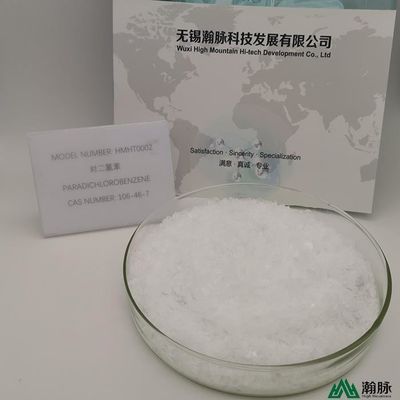

Model Number: HMHT0002
Other Names: Para-Dichlorobenzol; PDCB
Purity: 99.9% min.
CAS NO.: 106-46-7
EINECS NO.: 203-400-5
UN NO.: 3077
H.S. CODE NO.: 29039190.10
Standard: HG/T4489-2013
Appearance: Colorless or white crystal with a special fragrant scent
Density: 1.2475 g/mL at 25℃ (lit.)
Vapor Density: 5.07 (vs air)
Vapor Pressure: 1.03 mm Hg (25℃)
Melting Point: 52-54℃ (lit.)
Boiling Point: 174℃
Refractive Index: 1.5434
Water Solubility: Insoluble
Stability: Stable. Combustible. Incompatible with strong oxidizing agents, aluminum and its alloys, some plastics.
| Item | Specification |
Testing Results |
| Purity |
99.9% min. |
99.95% |
| Moisture |
0.1% max |
0.03% |
| Chlorobenzene |
0.02% max. |
0.01% |
|
M-Dichlorobenzene |
0.02% max. |
0.01% |
|
O-Dichlorobenzene |
0.1% max. |
0.07% |
|
HB (High Boiling) |
0.1% max. |
0 |
|
LB (Low Boiling) |
0.05% max. |
0.01% |
| Trichlorobenzene |
0.02 max. |
0 |
We can provide 25kg bag; 500kg bag or as per customers' requirement
![]()
![]()
![]()
![]()
Applications
![]()
Mainly used as raw materials for making mothball/preventatives, deodorizer, air refresher, pesticides and
Synthetic materials of PPS (Poly Phenylene Sulfide), etc.
1.IMDG: Class 9
2.Packaging group: III
3.Storage: Stored in a cool, dry, and well-ventilated place. Keep away from direct sunlight.
Keep away from heat/sparks/open flames/hot surfaces. Keep away from incompatible substances. Store locked up.
CAS number 79-11-8 refers to Chloroacetic Acid, also known as Monochloroacetic Acid (MCA). This compound is a significant building block in organic synthesis, particularly in the production of various agrochemicals (pesticides), pharmaceuticals, and other specialty chemicals. Here’s an overview of Chloroacetic Acid, focusing on its role as a pesticide intermediate:
Chloroacetic Acid (MCA) is a vital organochlorine compound and is one of the most important intermediates used in the chemical industry. It is a colorless crystalline substance that is highly soluble in water and organic solvents.
Chloroacetic Acid is extensively used as an intermediate in the synthesis of a wide range of agrochemicals, including herbicides, insecticides, and fungicides. Some of its significant contributions to pesticide production include:
Handling of Chloroacetic Acid must be done with great care due to its corrosive nature and potential toxicity:
The demand for chloroacetic acid is closely linked to the agricultural sector, which continues to grow due to the increasing need for higher crop yields. This trend suggests a steady or increasing demand for chloroacetic acid as an intermediate in producing effective agrochemicals.
Chloroacetic Acid (CAS 79-11-8) plays a critical role in the chemical industry, especially as an intermediate in pesticide production. Its effectiveness in forming a variety of agrochemicals makes it indispensable in modern agriculture. However, handling this chemical requires strict adherence to safety protocols to avoid health risks and environmental damage.
For more information on chloroacetic acid and its applications, or to explore how our chemical solutions at Wuxi High Mountain can support your business needs, please visit our website at high-mountain.cn.